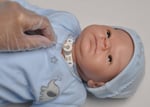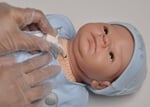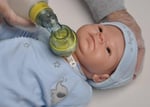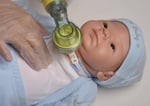Lifesaver CPR for Infants and Children With a Trach
Jump to:
Lifesaver CPR for infants and children with a trach
Follow these steps if your child is having trouble breathing or is not breathing.Airway
If your child is gasping or having trouble breathing, mucous may be plugging the trach tube.
- Suction the trach.
- If you can't get the suction catheter down or clear the trach, or if your child still isn't breathing, change the trach and fasten the new trach ties.
If in doubt, change the trach out!
Breathing
After changing the trach:
- Give 2 breaths with the manual resuscitator bag. You should see a gentle chest rise with each breath.
- If your child is still having trouble breathing, is gasping, or is not responding, shout, “Help! Call 911!”
Compressions
If your baby does not start breathing on their own or is not responding, start compressions.
- Draw an imaginary line between your child’s nipples.
- Press down on your child’s chest so it compresses 1/3 to 1/2 the depth of the chest. Do 30 quick compressions at a rate of at least 100 per minute. Push hard and fast.
For infants: Use two fingers.
For children over 1 year: Use the heel of one hand.
- Give 2 breaths to the trach with the manual resuscitator bag. Steps 2 and 3 (30 compressions and 2 breaths) are one cycle.
- After doing cycles of CPR for 2 minutes, call 911.
- If your baby still does not respond, keep doing cycles of breaths and chest compressions until emergency help comes.
 If you have a second person to help:
If you have a second person to help:
- One person first calls 911, then gives compressions continuously at a rate of at least 100 per minute.
- The other person gives 1 breath with the manual resuscitator bag every 2 to 3 seconds.




